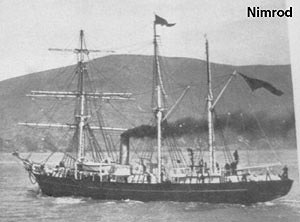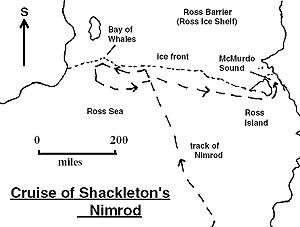
| Glasgow Digital Library | Voyage of the Scotia | BRUCE | PEOPLE | SHIP | ANTARCTIC | INDEX |
|---|

The aim of Shackleton's expedition in Nimrod was to make a successful journey to the South Pole. Shackleton went to Norway to search for a ship and purchased Nimrod - an old Scottish sealer which had been used in Newfoundland. She had been built in Dundee and was 40 years old. The cost was £5,000 and the refit cost added another £7,000. The captain was to be Rupert England and the first mate John King Davis.
Nimrod sailed in 1907 thanks to private sponsors, bank loans and a large number of creditors. When in Australia, Professor Mawson joined the expedition. The Australian government gave a grant of £5,000 and the New Zealand government £1,000. In return Nimrod was expected to do oceanographic work between Australia and Antarctica.
Shackleton's final port was Lyttelton in New Zealand. She was fully loaded and could not carry enough coal for her work in the Antarctic, so the New Zealand government provided a tramp steamer, Koonya, which towed Nimrod down to the Antarctic circle.
Nimrod carried two men recommended to Shackleton by William Bruce - James Murray, a biologist from Glasgow, and the second surgeon Alistair Forbes Mackay.
Shackleton in a written statement promised Scott he would not go to the McMurdo Sound area which Scott regarded as his province. Shackleton headed for Barrier Inlet but found the edge of the barrier had greatly changed. He did think of landing in an area he called the Bay of Whales - another indentation in the barrier. Shackleton had hoped to land here but the pack ice kept them from a landing site and Shackleton thought the barrier unstable. Against his promise he headed for McMurdo Sound.
Sixteen miles of pack ice prevented Nimrod reaching Hut Point which was in contact with the ice barrier, so they set up their base near Cape Royd.

| Glasgow Digital Library | Voyage of the Scotia | BRUCE | PEOPLE | SHIP | ANTARCTIC | INDEX |
|---|